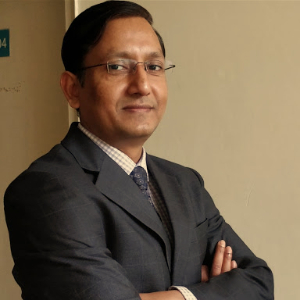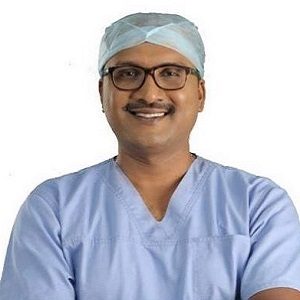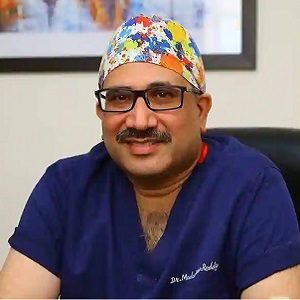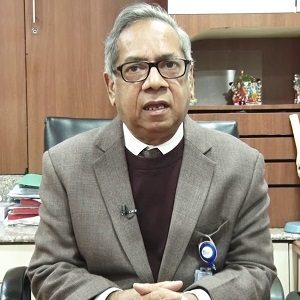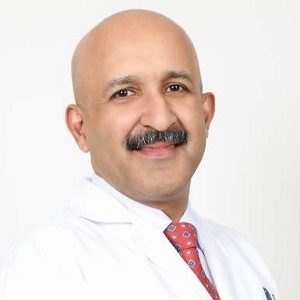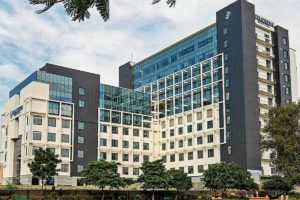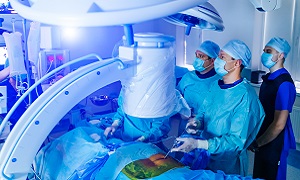Best Doctors in India for Hip arthroscopy
- Orthopedic & Spine Surgeon, New Delhi, India
- Over 14 years’ experience
Profile Highlights:
- Dr. Om Prakash Gupta is a reputed Spine Surgeon in India.
- He is currently functioning as a Consultant – Orthopedics & Spine at Max Smart Super Speciality Hospital, New Delhi
- He has over 14 years of experience.
- Orthopedic Surgeon, Chennai, India
- Over 21 years’ experience
Profile Highlights:
- Dr. A Navaladi Shankar is a well-known spine surgeon and orthopedist in Chennai with 21+ years of experience.
- He completed an MBBS from Al-Ameen Medical College, MNAMS from the National Board of Education, and a Diploma from Sri Ramachandra Medical College and Research Institute.
- Dr. Shankar holds expertise in Laminectomy, Lower Back Pain and Neck Pain Treatment, Arthritis Management, and Trauma Surgery.
- Orthopaedic Surgeon, Chennai, India
- Over 22 years’ experience
Profile Highlights:
- Dr. Kornad P Kosygan is one of the few Orthopedic surgeons in India with a double FRCS degree.
- He has been successful in the diagnosis and treatment of severe Orthopedic problems throughout his career.
- Dr. Kornad is invited as an exclusive Orthopedics Specialist from over six countries in the Asian and European subcontinent.
- Dr. Kosygan has sought extensive training and exposure in the department of Orthopaedics.
- Orthopaedic Surgeon, Chennai, India
- Over 25 years’ experience
Profile Highlights:
- Dr. Madan Mohan Reddy is one of the most acclaimed Orthopedic Surgeons in India with tons of experience and knowledge that he gained over the course of years.
- He has attended several courses across the world, in countries like Switzerland, Germany, Australia, and Italy.
- Orthopedic Surgeon, New Delhi, India
- Over 42 years’ experience
Profile Highlights:
- As one of the most experienced orthopedic surgeons in Delhi, Dr. Chander Shekhar has been practicing for 42 years. He is associated with Indraprastha Apollo Hospital as a consultant.
- Dr. Chander Shekhar is interested in Knee and Hip joint replacement and revision.
- He honed his expertise by completing a fellowship in shoulder and knee arthroscopy in the United States. Besides replacement & revision surgery, he has expertise in Birmingham Hip Resurfacing, BHR with stem, and Minimally Invasive Surgery.
- Orthopedic Surgeon & Spine Surgeon, New Delhi, India
- Over 18 years’ experience
Profile Highlights:
- Dr. Amit Kumar Agarwal is a Delhi-based orthopedic, joint replacement, and spine surgeon consultant who has been assuring joint and spine health for about 18 years.
- Dr. Agarwal has garnered numerous accolades for his work in treating Joints and Musculoskeletal Disorders, pain management, sports injury, and articular degeneration during his career.
- Orthopedic Surgeon, New Delhi, India
- Over 22 years’ experience
Profile Highlights:
- Dr. Vibhu Bahl is one of the finest Orthopedist and Joint Replacement Surgeon in India. He has experience of over 22 years in this field.
- Dr. Bahl has successfully performed multiple complex and primary total knee and hip replacements over his career. Besides these, he specializes in computer-assisted total knee replacements. Patients seeking Arthroscopy for shoulder dislocation, degeneration, and repair must consult him.
- Dr. Bahl participated as a Faculty in many Arthroscopy conferences.
- He is passionate about research and has a long list of publications in prestigious national and international journals.
- Orthopedist, New Delhi, India
- Over 20 years’ experience
Profile Highlights:
- Dr. Havind Tandon is one of the best Orthopedists in Delhi, having nearly two decades of experience. He practices as a senior consultant at Indraprastha Apollo Hospital.
- Many patients who need a knee replacement, repair, or osteotomy have benefitted from his enthusiasm and skill in the field.
- Dr. Havind Tandon worked with Jhonson & Jhonson as a Facilitator for the National Joint Replacement Program.
- Pain management counseling, Joint Replacement Surgery, Spinal Therapy, reverse shoulder replacement, neuropathy assessment, foot drop, treatment of complex fractures, and Adult Joint Reconstruction are just a few of the vital services provided by Dr. Havind Tandon.
- Dr. Tandon was also recognized for his work in the field of research.
- Orthopedic and Spine Surgeon, Gurugram, India
- Over 25 years’ experience
Profile Highlights:
- With over 25 years of experience, Dr. Rajesh Kumar Verma can be generally considered a boon for people suffering from complex, bone, joint, or spine disorders.
- Currently known as one of India’s leading spine experts in India, Dr. Rajesh Kumar Verma performs as many as 50 surgeries in a month. The types of surgeries he performs include all types of spine surgeries, joint replacements, as well as complex trauma surgeries.
- Orthopedic Surgeon, Chennai, India
- Over 25 years’ experience
Profile Highlights:
- Dr. Krishnamurthy K provides consultation at the Apollo hospitals of Chennai.
- He has also worked as a senior registrar and assistant surgeon earlier and has sound knowledge of his field.
- One can reach Dr. Krishnamurthy K for treatment of fractures, joints, shoulders, knees, hip replacement, etc.
Best Hospitals in India for Hip arthroscopy
Fortis Hospital, Shalimar Bagh
- City: New Delhi, India
Hospital Highlights:
- Fortis Hospital in Shalimar Bagh is a multi-super specialty hospital that strives to provide world-class patient care by leaving no stone unturned.
- Fortis, Shalimar Bagh, with 262 beds and a 7.34-acre footprint, provides the best level of medical care through its team of doctors, nurses, technicians, and management professionals.
Reliance Hospital, Mumbai
- City: Mumbai, India
Hospital Highlights:
- Reliance Hospital is one of the best super-specialty care hospitals in Navi Mumbai.
- The main purpose of this hospital is to become a trustworthy place for the best health and hope for society. The hospital is well connected to the suburbs of Mumbai and Navi Mumbai.
- The hospital has various specialty departments, viz., Accident & Emergency, Anesthesiology, Dental Services, Dermatology, Diabetology, Dietetics Nutrition, Endocrinology, ENT, Gastroenterology, General Surgery, Gynaecology And Obstetrics, Hepato Pancreato Biliary Surgery, Infectious Disease, Internal Medicine, Interventional Radiology, Laboratory Medicine, Minimal Access Laparoscopic Surgery, Nephrology, Neurosciences, Opthalmology, Orthopaedics, Paediatrics, Pain Management Palliative Care, Physical Medicine Rehabilitation, Plastic And Reconstructive Surgery, Psychiatry, Pulmonary Medicine, Radiology, Rheumatology, Transplant, Urology Andrology, Vascular Surgery
Lilavati Hospital & Research Centre, Mumbai
- City: Mumbai, India
Hospital Highlights:
- Lilavati Hospital & Research Centre is India’s premier multi-speciality tertiary care hospital and has been recognised as a global medical excellence centre.
- Lilavati Hospital & Research Centre has built an unrivalled level of trust with its patients over the years, thanks to a solid foundation that comprises cutting-edge facilities, the best medical competence, research, education, and charity endeavours.
- The hospital is quite proud of the fact that it now serves patients from all kinds of backgrounds, not just from the United States but from all around the world.
- The hospital has a total of 323 beds, one of the largest Intensive Care Units (ICUs), 12 Operation Theatres with modern amenities, over 300 consultants, and almost 1,800 personnel.
Venkateshwar Hospital, Dwarka, New Delhi
- City: New Delhi, India
Hospital Highlights:
- State-of-the-art technology and devoted healthcare professionals have been brought together under one roof at Venkateshwar Hospital to provide genuine medical care. The hospital’s professionals work together as a team to deliver the best possible treatment to their patients, using the most sophisticated equipment and information technology.
- Venkateshwar Hospital’s mission is to attain global excellence in healthcare by employing evidence-based, ethical clinical practices and cutting-edge technology by a team of highly skilled experts.
Hip arthroscopy
Arthroscopy is the examination of the interior of a joint by using an arthroscope, a flexible, small fiber-optic tube with a small camera connected to a monitor. This can allow a surgeon to get a magnified view of your joint. Specially designed arthroscopic surgical tools are also used to perform various types of minimally invasive joint surgery. Hip arthroscopy, which is known as a ‘hip-scope` is a minimally invasive procedure, in which an orthopedic surgeon examines the hip joint with the help of an arthroscope.
This procedure can help the surgeon diagnose the cause of hip pain or any other problem in your joint. Some hip conditions might also be treated arthroscopically. For performing this kind of procedure, the surgeon needs to make a few additional small incisions for creating access points for various arthroscopic needles, scalpels, or other special surgical tools.
Purpose
Hip arthroscopy can be recommended by your doctor if you are having a painful condition that doesn’t respond well to nonsurgical treatment. Nonsurgical treatment generally includes rest, medications, and physical therapy or injections that can reduce the inflammation.
Hip arthroscopy can help to relieve painful symptoms of several problems, that can damage the labrum, articular cartilage, or any other soft tissues that are surrounding the joint. This damage can result from an injury. In some cases, other orthopedic conditions can also result in problems, such as:
- Femoroacetabular impingement (FAI) is a disorder in which extra bone develops along the acetabulum or on the femoral head. This bone overgrowth, which is known as spurs, cause damage to the soft tissues of the hip during movement. Sometimes bone spurs can develop in both the acetabulum and femoral head.
- Snapping hip syndromes cause a tendon to rub across the outside of the joint. This type of snapping or popping is generally harmless and does not require treatment. The tendon in some cases can get damaged due to repeated rubbing.
- Dysplasia is another condition in which your hip socket becomes abnormally shallow. This can put more stress on the labrum for keeping the femoral head within the socket, and this makes the labrum more susceptible to tearing.
- Loose bodies are fragments of bone or cartilage that become loose and move around within the joint.
- Synovitis can cause inflammation in the tissues that surround the joint to become inflamed.
- Hip joint infection
Preparation
It is likely that your orthopedic surgeon will recommend you to see your primary doctor so that he/she is able to assess your general health prior to the surgery. He/she will identify any problems that can interfere with the procedure. If you are having certain health risks, a more extensive evaluation might be required before the surgery.
If your physical condition is healthy, then it is likely that your hip arthroscopy will be performed as an outpatient procedure. This means that you won’t need to stay at the hospital overnight.
Make sure that you inform your surgeon regarding any medications or supplements that you might be taking. You might need to stop taking some of these before the surgery.
The hospital or surgery center will contact you ahead of time to provide specific details of the procedure. Make sure that you follow the instructions regarding when you need to arrive, as well as when as you need stop consuming food and drink prior to your procedure.
Procedure
At the start of your procedure, your leg is going to be put in traction. This means that your hip is going to be pulled away from the socket enough for your surgeon to insert instruments, see the entire joint, and perform any treatment as needed.
Surgeons generally draw lines on the hip to indicate specific anatomy structures, such as bone, nerves, and blood vessels, as well as incision placements and portals for the arthroscope.
After the traction is applied, your surgeon will be making a small puncture in your hip, which will be about the size of a buttonhole, for the arthroscope. Through the arthroscope, your surgeon is able to view the inside of your hip and identify any damage.
In the meantime, fluid flows through the arthroscope, to keep the view as well as to control any bleeding. Images from the arthroscope are projected on the video screen so that your surgeon is able to see the inside of your hip as well as any problems. Next, your surgeon is able to evaluate the joint before he/she begins any specific treatments.
Once your surgeon is able to properly identify the problem, he/she will insert small instruments through separate incisions for repairing it. There are various procedures that can be done, depending on your needs.
For tasks such as shaving, cutting, suture passing and grasping, and knot tying, the surgeon uses specialized instruments. In most cases, special devices are used for anchoring stitches into the bone.
The length of the procedure generally depends on what your surgeon finds and the amount of work that needs to be done. At the end of the surgery, the incisions are generally stitched or covered with skin tapes. An absorbent dressing is next applied to the hip.
Recovery
Symptoms usually improve immediately following the procedure, but sometimes as the irritated joint lining heals, there might be a recurrence of some pain.
You might also feel a watery sensation in the hip or might even hear gurgling noises resulting from the fluid used during surgery. However, this will be absorbed by the body quickly. Swelling should subside in around a week, and any sutures will be removed in seven to ten days. Depending on the specific method used during your procedure, your full recovery time is going to vary.
Generally, hip arthroscopy patients need to use crutches for a week or two, after surgery, and they also require around six weeks of physical therapy. After around three to six months, patients should experience no pain after any physical activity.
Risks & complications
Generally, complications from hip arthroscopy are uncommon.
Any surgery in the hip joint has a small risk of injury to the surrounding nerves or blood vessels. Injury is a possibility in the joint itself.
There is also a small risk of infection, as well as blood clots forming in the legs.

